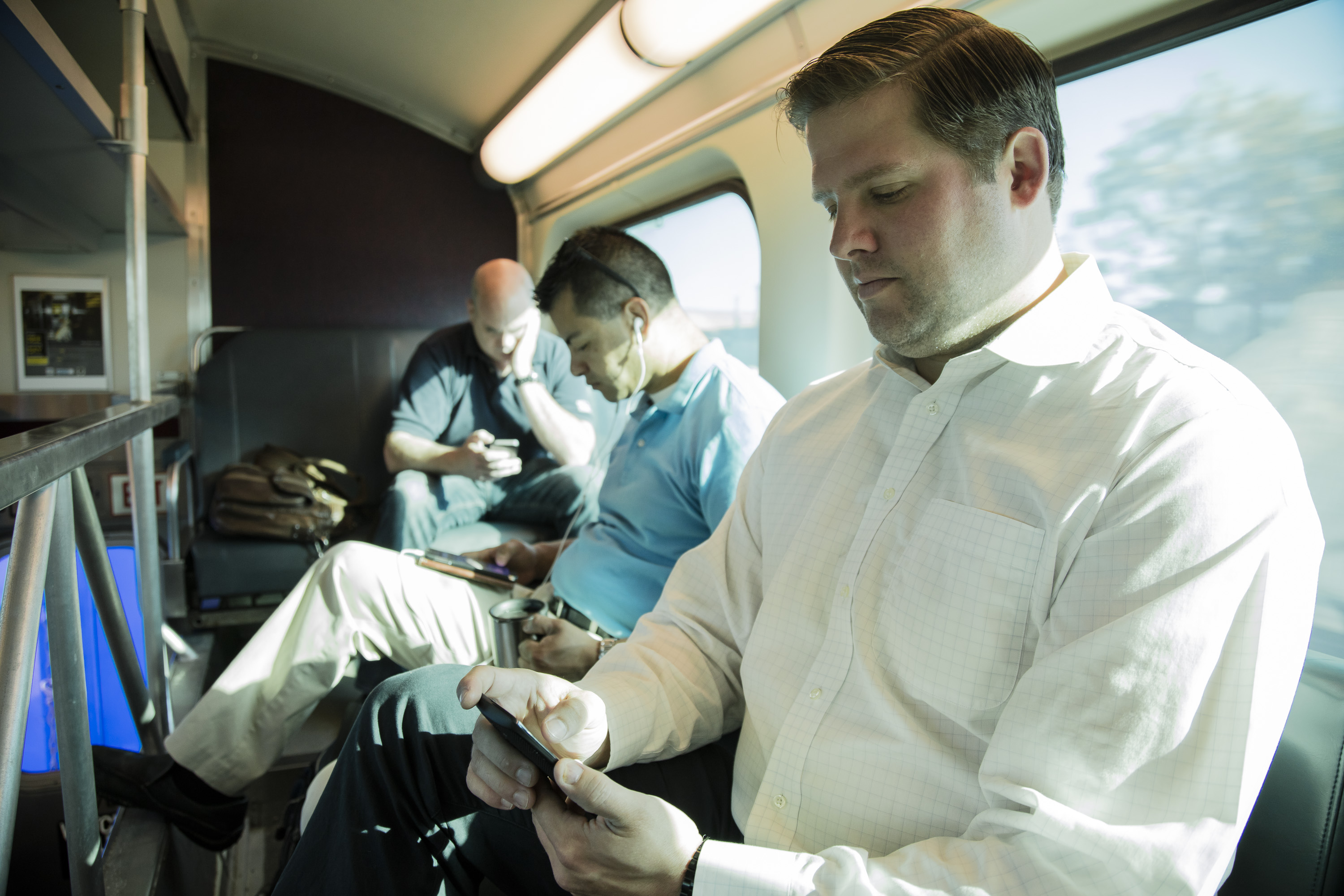 Commuters along Metra's Union Pacific northwest train line spend the majority of their journey glued to their smartphones and tablets. A new study from the Chaddick Institute of Metropolitan Development at DePaul finds technology use is on the rise on Metra. (Photo by Jeff Carrion)CHICAGO — Metra commuters in Chicago are increasingly doing things that would be illegal if they were driving — texting, reading email, shopping online or watching a movie — according to research from DePaul University’s Chaddick Institute for Metropolitan Development. More commuters in the Chicago area are opting to ride the train, in part because of this dependence on electronic devices, researchers found.
Commuters along Metra's Union Pacific northwest train line spend the majority of their journey glued to their smartphones and tablets. A new study from the Chaddick Institute of Metropolitan Development at DePaul finds technology use is on the rise on Metra. (Photo by Jeff Carrion)CHICAGO — Metra commuters in Chicago are increasingly doing things that would be illegal if they were driving — texting, reading email, shopping online or watching a movie — according to research from DePaul University’s Chaddick Institute for Metropolitan Development. More commuters in the Chicago area are opting to ride the train, in part because of this dependence on electronic devices, researchers found.
“Sophisticated personal electronic devices are changing the way Americans use public transportation,” said Joseph Schwieterman, director of the Chaddick Institute. “Heavy users of mobile technology are finding train travel to be particularly amenable to their digitally oriented lives. Many relish the idea of using their devices from origin to destination, giving this historic mode of travel a new competitive edge.”
The report is based on observation of 4,700 passengers on 53 commuter trains in the Chicago area in early 2015. Findings include:
- More than three times as many Metra riders are performing electronic tasks today compared to five years ago. Researchers measured tasks that are illegal while driving — such as texting and reading emails on phones. Fewer than 14 percent of passengers were performing such tasks at randomly observed points in 2010, compared to 44 percent this year.
- The digital divide in the region has largely disappeared. Trains serving different parts of the metropolitan region now have similar rates of technological use. As recently as 2013, rates of usage tended to be as much as 20 percent higher on some routes than others. All parts of the region now have usage within 5 percentage points of each other.
- Commuter dependence on electronic devices may be boosting Metra ridership, which has grown despite fare increases in 2012 that boosted the average cost of travel by more than 25 percent. This suggests that other factors — including the value passengers place on using electronic devices while traveling — may be offsetting some of the effects of rising fares.
-
Metra commuters still struggle to plug in and catch Wi-Fi. Metra is making progress in becoming more tech-friendly, but power outlets, Wi-Fi, and 3G/4G signals at downtown stations remain spotty. Wi-Fi onboard trains remains in the developmental stage.
- Millennium Station stands out as have the most tech-friendly features, offering passengers an airport-style waiting room with power outlets, Wi-Fi and a retailer with electronic accessories nearby. LaSalle Street and Union stations have the strongest 3G/4G signal strength, on average, among three major providers surveyed. None the five downtown stations have a publicly provided Wi-Fi system.
These findings are part of the Chaddick Institute’s Technology in Travel study, which includes more than 35,000 unique passenger observations since 2009. Passengers are counted once on a given trip. Each year, passengers are observed by trained data collectors to determine how they spend their time while traveling. Among the passengers observed, more than 14,000 were commuter rail passengers in the metropolitan Chicago region. Researchers have also observed 564 air, bus and rail trips throughout the United States. Complete results for intercity air, bus and train travelers and commuter rail passengers are available at http://bit.ly/chaddickresearch.
###
Source:
Joseph Schwieterman
jschwiet@depaul.edu
312-362-5731
Media Contact:
Kristin Claes Mathews
kmathew5@depaul.edu
312-241-9856